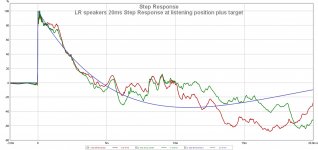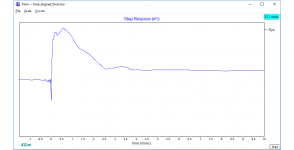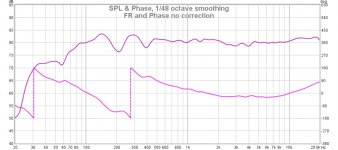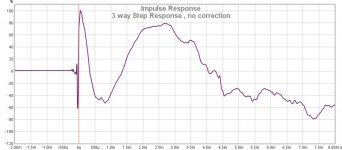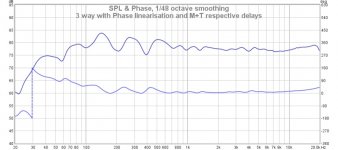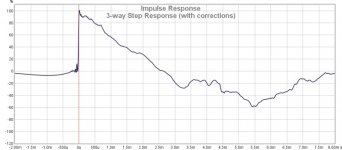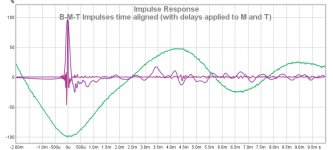Ah, you crazy Brits. Your "hoover" is the USA's "vacuum cleaner." Next thign you will be telling me is that a "tannoy" is a noun/verb for a public address speaker
Any advocates for active DSP/crossover here? Can be done quite cheaply (especially if can stomach low-end electronics that rhyme with Derringeror equivalent ) ... if one is a DIYer shouldn't one tailor one's system to a specific room? Yes, it requires more wires, components, and of course measurements and figuring curves and crossover points, but it should result in a much better listening experience.
I am doubtful as if DSP is a valid 'time aligned" because you have to perform signal processing on the original signal that has all sort of phase shift before it gets to the drivers - not to mention the phase shift when the signal going through the amplifier stage.
This is my step response.

Sorry, that step response on the right does not look time aligned... The sharp spike, negative going, looks to be the tweeter arriving before the woofer... The step response on the left is indeed time aligned with all direct sound arriving at the same time.
Let's have another look at that step response showing the first 20 ms, like in this example of my old 3-way's using digital XO and time aligned:
I have included the step response of an idealized or modelled speaker to show how closely the time alignment tracks at the listening position.
As a side note, these speakers also measure flat phase and group delay, not only at the LP, but also around a 6' x 2' grid area at the LP... Details in my sig.
PS. I am a huge fan of REW, but there are specialized software DSP tools that perform digital XO, time alignment, excess phase correction, reduce group delay, etc, that are very difficult or impossible to do in REW...
Attachments
This is the beauty of full range speakers - they are naturally transient perfect and time aligned. That is a big reason they sound so natural and lifelike when driven with a proper amplifier. Best is an amplifier with zero global feedback so that the phase information is not perturbed. WAW can be be made transient perfect with the right kind of XO.
Indeed.
It is easy to pick drivers that have a wide overlap. Keep the drivers within ¼ wavelength centre-to-centre at the XO and use a 1st order XO and you are almost guaranteed a speaker with very good time performance.
dave
So does this count as "time aligned" with the step response below?
The tweeter is negative going probably because the xo is an even order filter which then requires one to be opposite phase otherwise a deep cancellation null would result. This can be fixed with a wide band driver with a first order notch filter filling in the hole as B&O did with their Hole-Filler speaker.
Today, there's an easier and better way. It's a fabulous software called REW. You can do time-alignment with it.
Analog dual or semi-dual channel mode with common soundcard for mic and signal output is needed to measure accurate timing to mic and timing differences of multiple drivers separately.
Semi automatic polar response measurement is missing in REW. It is still quite complex waste and not recommended for loudspeaker engineering at least with Umik-1 or any other usb mic, because actual semi/dual channel mode is not available. Acoustic reference is just pita.
Please consider advertising better gear if topic is "timing" and you visualize timing differences.
As I gain experience with FIR processing it's getting easier and easier to achieve excellent alignment throughout the spectrum...even through the sub range if overall latency can be tolerated.
New world...it makes the opening alignment example seem almost primitive...
(not to disparage it
This is also my experience. I’m using the miniDSP 2x4HD with FIR crossover filters created in rePhase. Very simple to do but extremely effective.
I guess Stereophile was very lucky to have found the one spot (or possibly arc) in the room where that wave coincidence is true for their microphone. But shouldn't there be a spot in a room where any (or all or at least, some other) two-way system shows the same perfection?Here is an example of a rare transient-perfect (hence, time aligned) speaker measured by Stereophile. According to John Atkinson, he can count the speakers that he has measured as transient perfect and time aligned on one hand.
As often found in this forum, you see a combination of hyper-sensitivity to physics principles (which may have no relevance to hearing) combined with naiveté about auditory assessment (as reflected in taking anecdotal "observations" of the most casual and subjective sort as "evidence").
That's what's so nice about Toole's body of work. He combines good physics with good blind testing.
Doesn't anybody have links to reports (esp in peer reviewed legitimate journals) on the matter of phase and time-alignment perception?
B.
Last edited:
Now for those of us lucky enough too have nearly full-range electrostatic speakers with striking clarity and sparkling clear sound, you'd think time precision would be a non-issue.Yes!
I had the pleasure some weeks ago to listen to a good fullrange the first time (pretty late, I wish I had done it sooner).
But anyone who has worked with ESL speakers knows they have strong phase deviations arising from the way they are interfaced to conventional amps.*
And the greatly admired Quad ESLs have phase smearing across their diaphragms caused by the clever system of what might be called a crossover across the width of their panels.
In general, ESLs are large beasts. So you can move your mic around to find a recording location to suit your beliefs in phase coherence but everywhere else obviously won't have coherence.
My point is that here we have sparkling clarity in a single-speaker configuration. We do have good time alignment but not phase coherence.
B.
*granted, when connected to high-voltage amps with minimal phase deviation start to finish they are even more wonderful
Last edited:
Sorry, that step response on the right does not look time aligned... The sharp spike, negative going, looks to be the tweeter arriving before the woofer... The step response on the left is indeed time aligned with all direct sound arriving at the same time.
Thank you for highlighting that.
The negative spike is from REW. I think it's called a pre-spike or something. The actual measurement starts from 0 at X-Y axis.
PS. I am a huge fan of REW, but there are specialized software DSP tools that perform digital XO, time alignment, excess phase correction, reduce group delay, etc, that are very difficult or impossible to do in REW..
Yes, I'm well aware of that. This thread is about Time-Aligning a woofer with a tweeter with passive crossover.
Phase alignment is Time alignment. When you align the acoustic centers, the phase of the two drivers at the crossover frequency crosses perfectly.
That's why i said earlier, Time alignment, Phase alignment, Phase Coherent are all the same. Once we accept this, then it's easier to understand how to time align drivers.
If not, then how do you know when your drivers are Time aligned. How do you know the acoustic centers are aligned.
Sorry but you are wrong. TA is not equal to PA.
# Phase aligned is when 2 sources emitting the same frequency, summing perfectly, to produce 6 dB more sound pressure than one individual.
# Time aligned is when two sources, reproducing a pulse, emit the pulse at the same time
Surely you must see that a system may be phase aligned but not time aligned - say that one speakers is placed 1 meter from an other one - these may play in phase for a certain frequency but never send a pulse at the same time. OK?
A time aligned system plays in phase but not necessarily the other way.
//
Analog dual or semi-dual channel mode with common soundcard for mic and signal output is needed to measure accurate timing to mic and timing differences of multiple drivers separately.
Semi automatic polar response measurement is missing in REW. It is still quite complex waste and not recommended for loudspeaker engineering at least with Umik-1 or any other usb mic, because actual semi/dual channel mode is not available. Acoustic reference is just pita.
Please consider advertising better gear if topic is "timing" and you visualize timing differences.
Yes, you brought up a good point. Unfortunately as DIYers, that's all we can afford. REW is not the same as professional grade measurement equipment but I don't think it's so bad that the measurements are false.
However, I'll be happy to re-run my measurements if you can provide me with the professional grade hardware and software.
Please note, my intention for this thread is not to promote my speakers. I have no speakers to sell. My sole purpose is to help members understand better what is the meaning of time-aligning a woofer and a tweeter and how it can be done passively with the use of DSP.
I happened to have a measurement on a 3-way passive, both raw and then with help of OpenDRC (for FIR phase correction) and DCX (purely for time delay only, otherwise run full open on all ways). Of course the corrected system is by design passive tri-amped. Shown one same channel, measured at the same LP at about 2,5 m.
Measured in-room, plenty of reflections visible on graphs.
Measured in-room, plenty of reflections visible on graphs.
Attachments
Last edited:
Sorry but you are wrong. TA is not equal to PA.
# Phase aligned is when 2 sources emitting the same frequency, summing perfectly, to produce 6 dB more sound pressure than one individual.
# Time aligned is when two sources, reproducing a pulse, emit the pulse at the same time
Surely you must see that a system may be phase aligned but not time aligned - say that one speakers is placed 1 meter from an other one - these may play in phase for a certain frequency but never send a pulse at the same time. OK?
A time aligned system plays in phase but not necessarily the other way.
//
Yes.... you are so right. I actually said that in post #54.
I started this thread by making a provocative statement regarding phase and time alignment. What I discovered is there's a lot of confusion regarding phase and time-alignment.
No, no, please don't apologize. I just want to help members understand what is the meaning of time-alignment in a 2-way speaker.
Actually, what I said earlier is inflammatory to experts. They are completely wrong, especially the part that says Phase alignment is Time alignment. It is NOT. It is the other way round. When the woofer and tweeter are time-aligned, the phase at the crossover frequency is aligned.
I happened to have a measurement on a 3-way passive, both raw and then with help of OpenDRC (for FIR phase correction) and DCX (purely for time delay only, otherwise run full open on all ways). Of course the corrected system is by design passive tri-amped. Shown one same channel, measured at the same LP at about 2,5 m.
Measured in-room, plenty of reflections visible on graphs.
Hi Draki
Thank you for your graphs. They look very impressive. The wonders of technology today.
May I ask what software you used for the measurements. I hope it's free. Poor man here.
Thank you for highlighting that.
The negative spike is from REW. I think it's called a pre-spike or something. The actual measurement starts from 0 at X-Y axis.
Could you post an early waterfall plot using these settings?

That would show the hand-off from one driver to the next.
Hi Draki
Thank you for your graphs. They look very impressive. The wonders of technology today.
May I ask what software you used for the measurements. I hope it's free. Poor man here.
Not exactly one of the 1% either ......
Used HolmImpulse to establish the arrival time difference.
RePhase for the phase linearisation.
And as you see, REW for the attached measurements. All free.
- Status
- This old topic is closed. If you want to reopen this topic, contact a moderator using the "Report Post" button.
- Home
- Loudspeakers
- Multi-Way
- What is Time-Alignment
